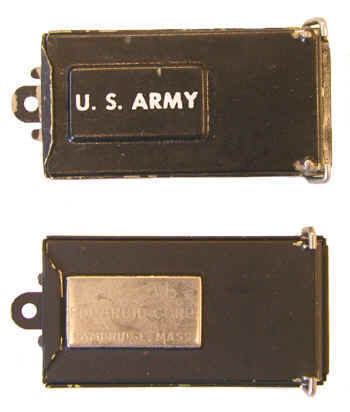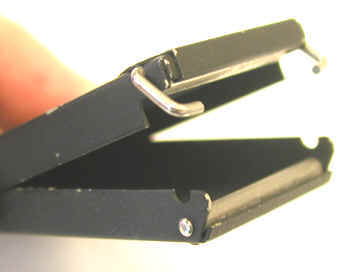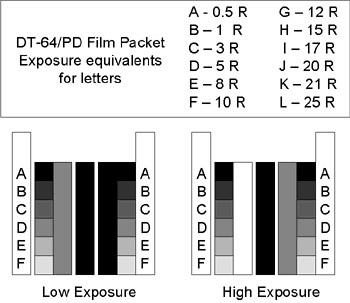PH-656/PD and FB-5b Self-developing Film Holders (early 1950s)

This film holder is a high range self-developing film dosimeter. The film packets that were used with this system were the Radiac DT-64/PD (0.5-25 R) and DT-65/PD (15-420 R). The holder is a steel box (1.25” x 2.25” x 0.25”) lined on the top and bottom with 1 mm of lead. It is hinged at one end and latched at the other. The jaws at the latched end of the holder are rounded so that they spread the developing agent over the film when the packet is pulled from the holder.
Each film packet consists of three negative emulsion film strips separated from three corresponding positive film sheets by a pod containing the developing solution. When the packet is pulled out of the holder, the pod bursts and the developing solution is spread between the negative strips and the positive sheets. After one minute, the packet is opened and the dose determined by viewing the darkening of the three positive sheets. For the DT-64/PD packet, the positive sheet on the left side is used for low exposures (0.5 to 10 R), the sheet on the right side is used for high exposures (12 to 25 R), and the third, in the center, is a test sheet used to determine that the unit worked properly. The darkening of the two outermost sheets is compared with an adjacent graded scale that employs letters (A to L). The letter corresponds to the exposure.


There are two examples in the collection. One has “U.S. Army” painted on one side in white letters. The other example has “FB-5b, Polaroid Corp., Cambridge, Mass” engraved on a metal plate attached to one side. According to an unpublished manuscript by K.Z. Morgan (1951), the self-developing film badge was developed by E.H. Land and W.A. Shureliff of the Polaroid Corporation.
The earliest reference to the device that I have found is a December 1950 A.P. press release. Selected quotes follow:
“The army has developed [good pun, if intentional] a different type of detector which it believes will be capable of mass production to meet both military and civil defense needs.” “This detector, described by the army signal corps last month, consists of a small metal case containing a film and a developing solution. A scale on the outside of the flat case can be read by the wearer and the extent of radiation exposure determined without the aid of any other instrument.”
Donated by Ron Kathren.
References
- Department of the Army Technical Bulletin TB SIG 226, May 28, 1951.
- Radiation Monitoring in Atomic Defense. D. Van Nostrand. 1951. p. 62.
